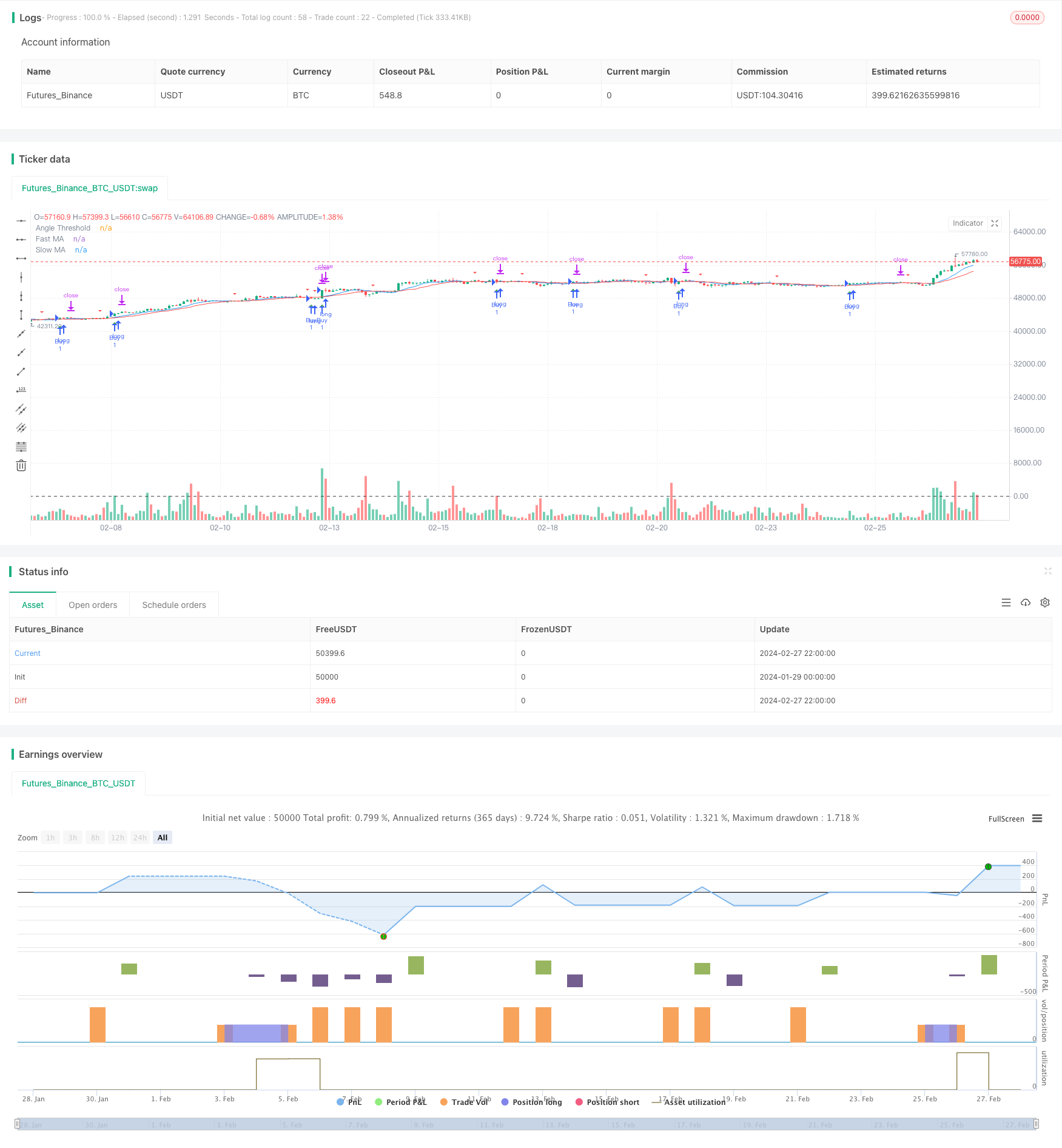
概述
该策略是一个基于5分钟时间周期的比特币scalping策略。它利用9周期和15周期的移动平均线交叉以及K线形态作为交易信号。具体来说,当快速移动平均线向上穿越慢速移动平均线,且K线形成锤头或纯阳线时产生买入信号;当快速移动平均线向下穿越慢速移动平均线时产生卖出信号。入场后设置0.5%的止损和0.5%的止盈。
策略原理
该策略使用两个不同周期的移动平均线进行趋势判断。9周期移动平均线更加灵敏,可以捕捉短期趋势;15周期移动平均线较为稳定,能过滤掉部分噪音。当较快的移动平均线向上穿越较慢的移动平均线时,表示短期趋势转为上涨;反之,短期趋势转为下跌。
另外,该策略还结合K线形态进行过滤。仅在形成锤头或纯阳线等强势K线时才产生买入信号。这能避免在盘整过程中产生错误的交易信号。
具体的交易信号和规则如下:
9周期移动平均线上穿15周期移动平均线,且15周期移动平均线角度大于30度时,表示短期趋势转为上涨;
此时如果K线形态为锤头或纯阳线,表明上涨势头强劲,则产生买入信号;
9周期移动平均线下穿15周期移动平均线时,表示短期趋势转为下跌,此时产生卖出信号,不需要判断K线形态;
入场后设置0.5%的止损和0.5%的止盈。
优势分析
该策略具有以下几个优势:
回撤小、获利稳定。作为scalping策略,设置了较小的止损止盈幅度,单笔损失有限,即使遇到逆市也不会大幅回撤。
信号比较明确。移动平均线交叉结合K线形态识别趋势转折点,避免无效突破。
容易实现自动交易。策略信号规则清晰,参数调整简单,适合算法交易。
适合比特币高波动行情。作为数字货币,比特币波动较大,短期调整频繁,运用该策略可以捕捉短线交易机会。
风险分析
该策略也存在一些风险:
容易产生多次小额损失。比特币行情两面性较强,止损被触发概率大,连续止损会形成亏损;
参数设置需要不断优化。移动平均线参数和止损止盈设置需要根据市场调整,否则效果会打折扣;
效果依赖趋势。在盘整行情中,该策略可能会产生频繁交易但小额盈亏。
对应解决方法如下:
加大单笔订单规模,确保盈亏比合适;
调整参数设置,跟随市场变化;
识别行情状态,避免在盘整中无效交易。
优化方向
该策略还可从以下几个方向进行优化:
增加止损止盈自适应机制。比如,跟踪移动平均线实时调整止损线、动态更改目标利润等;
结合其他指标过滤信号。例如,RSI指标判断超买超卖、成交量放大等;
测试不同品种合约。运用该策略进行原油、股指期货等品种的scalping交易;
进行参数优化和回测优化,确定最佳参数。
总结
总体来说,该策略是一个有效的比特币短线scalping策略。它简单并且易于实施,可配置性较高。通过不断优化和调整,可望获取稳定的scalping交易收益。 但是交易中也需要警惕风险,合理控制止损和仓位。此外,可根据市场和自身情况进行策略优化,以获得更好的效果。
/*backtest
start: 2024-01-29 00:00:00
end: 2024-02-28 00:00:00
period: 2h
basePeriod: 15m
exchanges: [{"eid":"Futures_Binance","currency":"BTC_USDT"}]
*/
//@version=4
strategy("Moving Average Crossover Strategy with Candlestick Patterns", overlay=true)
// Define input parameters
fast_length = input(9, "Fast MA Length")
slow_length = input(15, "Slow MA Length")
stop_loss_percent = input(0.5, "Stop Loss (%)")
target_percent = input(0.5, "Target (%)")
angle_threshold = input(30, "Angle Threshold (degrees)")
// Calculate moving averages
fast_ma = sma(close, fast_length)
slow_ma = sma(close, slow_length)
// Define candlestick patterns
is_pin_bar() =>
pin_bar = abs(open - close) > 2 * abs(open[1] - close[1])
high_tail = max(open, close) - high > abs(open - close) * 1.5
low_tail = low - min(open, close) > abs(open - close) * 1.5
pin_bar and high_tail and low_tail
is_marubozu() =>
marubozu = abs(open - close) > abs(open[1] - close[1]) * 0.75
no_upper_shadow = high == max(open, close)
no_lower_shadow = low == min(open, close)
marubozu and no_upper_shadow and no_lower_shadow
is_full_body() =>
full_body = abs(open - close) > abs(open[1] - close[1]) * 0.95
full_body
// Plot moving averages
plot(fast_ma, color=color.blue, title="Fast MA")
plot(slow_ma, color=color.red, title="Slow MA")
// Calculate angle of slow moving average
ma_angle = abs(180 * (atan(slow_ma[1] - slow_ma) / 3.14159))
// Generate buy/sell signals based on angle condition and candlestick patterns
buy_signal = crossover(fast_ma, slow_ma) and ma_angle >= angle_threshold and (is_pin_bar() or is_marubozu() or is_full_body())
sell_signal = crossunder(fast_ma, slow_ma)
// Calculate stop-loss and target levels
stop_loss_level = close * (1 - stop_loss_percent / 100)
target_level = close * (1 + target_percent / 100)
// Execute trades based on signals with stop-loss and target
strategy.entry("Buy", strategy.long, when=buy_signal)
strategy.exit("Exit", "Buy", stop=stop_loss_level, limit=target_level)
// Plot buy/sell signals on chart (optional)
plotshape(series=buy_signal, title="Buy Signal", location=location.belowbar, color=color.green, style=shape.triangleup, size=size.small)
plotshape(series=sell_signal, title="Sell Signal", location=location.abovebar, color=color.red, style=shape.triangledown, size=size.small)
// Plot angle line
hline(angle_threshold, "Angle Threshold", color=color.black, linestyle=hline.style_dashed)